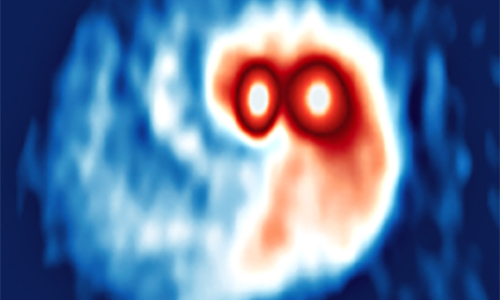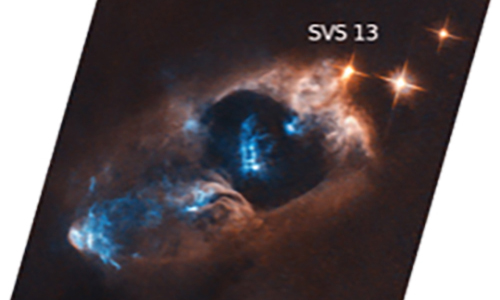It’s rare to witness the early stages of the birth of new planets in any star system. Rarer still is the opportunity to witness it in a binary star system.
Yet this is exactly what researchers at The University of Manchester and Instituto de Astrofísica de Andalucía (IAA) have recently been able to do – and with an unprecedented level of detail.

Exciting firsts
The double-starred system in question, SVS 13, has been observed for over 30 years by researchers around the world. Still in an ‘embryonic’ stage of development, it is now known to be composed of two young stars orbiting each other, with three disks of dust and gas surrounding them: one around each star (circumstellar disks) and one that surrounds both (a circumbinary disk).
All have the potential to form planets through the accumulation of material into larger and larger structures over millions of years. The worlds of SVS 13 would have two suns in the sky – some being places of constant daylight for parts of the year.
Until now, very little has been known about how planets form in binary star systems, where both stars have a gravitational influence on the behaviour of material in each disk.
Using data from the Very Large Array (VLA) in New Mexico and the Atacama Large Millimetre/submillimetre Array (ALMA) in Chile, the team was able to survey these disks with groundbreaking accuracy and detail, producing the most complete study of a binary star system in formation and filling in some of the key gaps in our knowledge.
As well as the first clear evidence for the presence of circumstellar and circumbinary disks in the system, “the kinematics of the gas around the binary has been obtained, with evidence for infall (material falling into the stars) and rotation [around the stars]”, says Ana Karla Díaz-Rodríguez, the Manchester researcher who led the study.
Infall is a sign that the stars are continuing to gather material from the system and grow. Rotation of the gas and dust disk, seen around one star in particular, would be the origins of an orbit for any planets that form from this material.
30 different molecules that make up the vast clouds of material were identified by the researchers. Of these, 13 are complex organic molecules that are thought to be involved in the creation of life. Commenting on the finding, Díaz-Rodríguez said that “the start of life is too complicated to positively say that the presence of these molecules will lead to it, but it is, without a doubt, a requirement for it”. Encouraging signs, then.

An international project
Crucial to the study was data collected from ALMA, an array of 66 radio antennas positioned at 5,000 metres above sea level in the Atacama Desert in Chile. By observing radio waves that have travelled light years from the distant objects that produced them, it is able to give details about the gas and dust around protostars (stars in formation) with a degree of sensitivity and resolution that is unmatched by any other telescope. It is the best instrument of its type in the world.
ALMA is an international collaboration between Chile and several countries in Europe, North America and Asia. The running of the telescope is split between regional centres across the world, including the Jodrell Bank Centre for Astrophysics at Manchester.
This research is the latest in a long line of extraordinary discoveries made by what is the most expensive ground telescope in the world. Other research groups have used ALMA to observe colliding galaxies, comets and black holes with cutting-edge clarity.
International collaboration did not only extend to the equipment used in the study. The 30 years’ worth of observations of SVS 13, carried out by researchers at the IAA in Spain and the Instituto de Radioastronomía y Astrofísica (IRYA) in Mexico, were “crucial” to the project according to Díaz-Rodríguez, of Jodrell Bank and Manchester’s Department of Physics and Astronomy.
The data the VLA collected over these three decades helped the group “infer the geometry and orientation of the system”, Díaz-Rodríguez says. With the combination of ALMA and VLA data the group could “derive several parameters, such as the protostellar and disk masses, and [the] temperature of the gas”, among other features.

What next?
Planet formation is an awe-inspiring process. Over millions of years, the huge clouds of dust and gas that aren’t sucked into the heart of the stars coalesce into celestial bodies of all shapes and sizes. Unfortunately, the colossal timescales at play make it impossible for us to observe the full process taking place in a single system.
Despite this, Díaz-Rodríguez and her group are not finished exploring SVS 13. As is often the case in science, this research has answered many questions but posed many more. They hope to establish whether hints in the data of a third, or even fourth, star in the system can lead them to a new discovery.
She says that other areas of enquiry include finding out whether “spirals [of infalling gas and dust] in the circumbinary disk… are definitely feeding material to the stars?”. If so, it would mean that some material is being lost to the star and will not be used to form planets. The team also hopes to “refine estimations of the sizes of the disks”, to help improve computer simulations of the system.
The team is “working now on several ALMA proposals to request more observing time to answer these questions”. If granted, it can continue to shed light on this fascinating system – and the amazing processes that build entire worlds from powder and gas.
If you enjoyed this post, be sure to subscribe on our homepage to keep up to date with the latest posts from The Hub.
Words: Joseph Cousins
Images: Shutterstock, Ana Karla Díaz-Rodríguez
